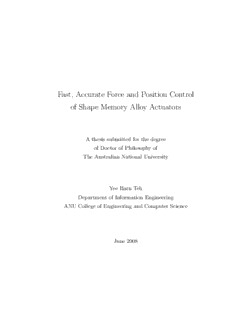
Fast, Accurate Force and Position Control of Shape Memory Alloy Actuators PDF
Preview Fast, Accurate Force and Position Control of Shape Memory Alloy Actuators
Fast, Accurate Force and Position Control of Shape Memory Alloy Actuators A thesis submitted for the degree of Doctor of Philosophy of The Australian National University Yee Harn Teh Department of Information Engineering ANU College of Engineering and Computer Science June 2008 2 This thesis contains no material which has been accepted for the award of any other degree or diploma in any university. To the best of the author’s knowledge and belief, it contains no material previously published or written by another person, except where due reference is made in the text. Yee Harn Teh June 2008 4 Acknowledgements Therearemanypeoplewhohavemadecontributions,bothdirectlyandindirectly, towards the completion of this thesis. I would like to name a few. First and foremost, I would like to express my sincerest gratitude to my supervisor, Dr. Roy Featherstone. Roy’s help has been extremely enormous, and his enthusiasm has sparked my own in this wonderful work. This work would never have been completed without his advice and guidance. Apart from Roy, I would also like to thank Dr. Zbigniew Stachurski and Dr. Robert Mahony for being on my Ph.D. supervisory panel. Roy and Zbigniew especially, thank you for the wonderful coffees and brilliant discussions together. Iwouldalsoliketoexpressmygratitudetomyparents,andmythreebrothers, who provided me with unconditional advice, support and love. They have never been far from my heart. And finally to Aya, my partner, thank you. i ii Abstract Shape memory alloy (SMA) actuators have great potential in niche applications where space, weight, cost and noise are crucial factors. Despite many of the advantages, they remain mostly as experimental actuators due to their perceived slow response speed, low accuracy and controllability. Especially in situations where there is a moving link or an external payload, the problem of limit cycles has been pursued by various researchers but never fully solved. In this thesis, practical, effective control systems are applied to achieve fast and accurate force and position control of SMA wire actuators. Investigations into very high-frequency responses from SMAs are initially ex- plored, which produce surprising results of audio frequency responses. This dis- covery has led us towards using high-bandwidth control systems as a possible method of eliminating limit cycles. Frequency response analysis of SMA actua- torshavealsobeencarriedout. Basedontheresults, linearforcemodelsforsingle SMA wires as well as for an actuator comprising of an antagonistic pair of SMA wires have been developed. A position model for an antagonistic SMA-actuated robotic joint has also been developed based on the force models. These models are integral in the design, tuning and simulation of various control systems for SMA actuators. High-bandwidth PID control has been employed in the force control of single SMA wire actuators. More importantly, it forms the main control component in the differential force control architecture for antagonistic SMA actuators. Other components are the anti-slack mechanism, the rapid-heating mechanism and the anti-overload mechanism. The closed loop response is fast and accurate, even in the presence of external motion disturbances. There is generally no limit cycles in theactuator’sdifferentialforceoutput; andtheperformanceisunaffectedbylarge loadinertias. Thisthesisalsopresentsatwo-looparchitectureforpositioncontrol, in which a position feedback loop is added to the force control architecture. Experimental results demonstrate highly accurate position control with no limit iii cycles in the presence of external loads. The accomplishments reported in this thesis represent a significant develop- ment in making SMA actuators faster, more accurate and effective. It is aspired that the results and control methods in this work can be utilised in enabling practical SMA technologies for robotic and commercial applications. iv List of Source Publications Most of the discussions and results presented in this thesis are based on the following publications. Several passages in this thesis contain materials that have been copied verbatim, or with some adaptation, from these publications. All such copied materials were originally written by myself. i. R. Featherstone and Y. H. Teh. Improving the Speed of Shape Memory Alloy Actuators by Faster Electrical Heating. In Proceedings of the 9th International Symposium on Experimental Robotics, Singapore, 18-21 June 2004. ii. Y. H. Teh and R. Featherstone. A New Control System for Fast Motion Control of SMA Actuator Wires. In The 1st International Symposium on Shape Memory and Related Technologies, Singapore, 24-26 November 2004. iii. Y. H. Teh and R. Featherstone. Experiments on the Performance of a 2- DOF Pantograph Robot Actuated by Shape Memory Alloy Wires. In Pro- ceedings of the 6th Australasian Conference on Robotics and Automation, Canberra, Australia, 6-8 December 2004. iv. Y. H. Teh and R. Featherstone. Experiments on the Audio Frequency Response of Shape Memory Alloy Actuators. In Proceedings of the 7th Australasian Conference on Robotics and Automation, Sydney, Australia, 5-7 December 2005. v. Y.H.TehandR.Featherstone. AccurateForceControlandMotionDistur- bance Rejection of Shape Memory Alloy Actuators. In Proceedings of the IEEE International Conference on Robotics and Automation, Rome, Italy, 10-14 April 2007. vi. Y.H.TehandR.Featherstone. AnArchitectureforFastandAccurateCon- trol of Shape Memory Alloy Actuators. International Journal of Robotics Research. Submitted for review, May 2007. v vii. Y. H. Teh and R. Featherstone. Frequency Response Analysis of Shape Memory Alloy Actuators. In Proceedings of the International Conference on Smart Materials and Nanotechnology in Engineering, Harbin, China, 1-4 July 2007. vi
Description: